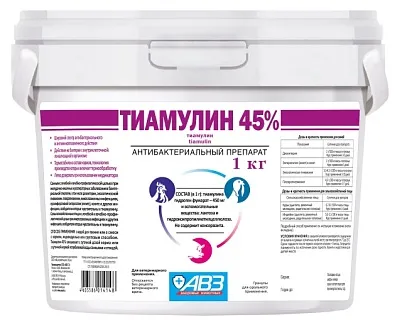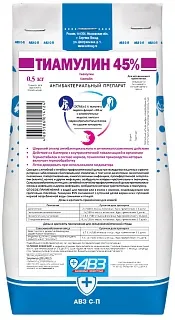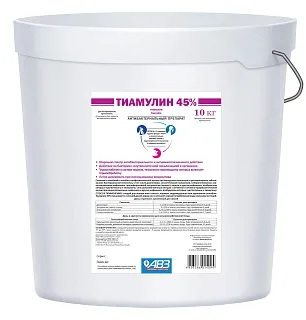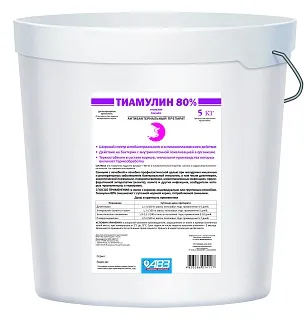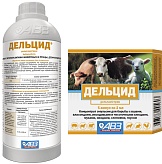Product benefits:
-
A wide range of antibacterial action, including against intracellular microorganisms.
-
It is thermally stable as a component of feed, the production technology of which includes heat processing.
-
It is easily dispensed with a medicator.
- It is used in a mixture with feed or water for drinking.
Chemical composition and pharmacological properties
1 g of Tiamulin 45%, 80% contains tiamulin, hydrogen fumarate (450 mg and 800 mg, respectively) as an active ingredient; and lactose and hydroxypropylmethyl cellulose as excipients.
Appearance: white or light-grey to yellow granules.
Tiamulin 45%, 80% belongs to the pharmacotherapeutic group "macrolides and azalides".
Tiamulin hydrogen fumarate, which is a component of the drug, is a semi-synthetic antibiotic of the pleuromutin group; it has a broad range of action against mycoplasmas, including Mycoplasma hyopneumoniae, M. hyorhinis, M. hyosynoviae, M. synoviae, M. gallisepticum, M. meleagridis; gram-positive and some gram-negative bacteria, including Actinobacillus spp., Bacteroides spp., Campylobacter spp., Clostridium spp., Corynebacterium spp., E. coli, Enterococcus cecorum, Erysipelothrix spp., Fusobacterium spp., Haemophilus spp., Klebsiella pneumoniae, Leptospira spp., Listeria spp., Pasteurella spp., Staphylococcus spp., Streptococcus spp., Treponema hyodesenteriae, Lawsonia intracellularis, and brachyspira (Brachyspira hyodysenteriae, Brachyspira innocens, Brachyspira. pilosicoli, Brachyspira suis); it is not effective against Enterobacteriaceae (Salmonella spp. and Escherichia coli).
The mechanism of bacteriostatic action of tiamulin is due to a disruption in the process of microbial cell protein synthesis (including in intracellular organisms) at the ribosomal level, which leads to suppression of the growth and development of microorganisms.
After oral administration, tiamulin is rapidly absorbed in the gastrointestinal tract of animals and penetrates into many organs and tissues, reaching maximum concentrations in 0.9–1.0 hours after administration. Tiamulin is metabolized to inactive metabolites and is excreted mainly with feces and urine.
According to the extent of exposure, Tiamulin 45%, 80% refers to moderately hazardous substances (hazard class 3 according to GOST 12.1.007); when used in recommended doses it is well tolerated by pigs and poultry.
Indications
Tiamulin 45%, 80% is used for treatment and prevention of bacterial gastrointestinal and respiratory diseases, including dysentery, enzootic pneumonia, pleuropneumonia, proliferative enteropathy in pigs (ileitis), colitis and other infections, caused by pathogens sensitive to tiamulin. Tiamulin 45% is used in poultry for treatment and prevention of mycoplasma infections and other infections caused by sensitive pathogens.
Contraindications
Tiamulin 45%, 80% is contraindicated in individual hypersensitivity to the components of the drug. Do not administer the product to pigs with severe liver and kidney injury. It is prohibited to use Tiamulin 45% in laying hens whose eggs will be used for food, as well as in rearing flocks less than 2 weeks before the start of egg laying, due to the accumulation of tiamulin in eggs.
Dosage and administration
Tiamulin 45% is administered with water for drinking or in a mixture with feed, individually or in groups. Tiamulin 80% is administered in a mixture with feed, individually or in groups.
Tiamulin 45% is mixed with a daily dose of feed or with the daily amount of water consumed by pigs and poultry. Tiamulin 80% is mixed with the estimated daily amount of feed consumed by pigs. Tiamulin 45%, 80% is thermally stable, which makes it possible to introduce the drug into the composition of feeds, produced with the use of heat treatment technology.
The doses and frequency of dosing in pigs are shown in Table 1.|
Indications for use |
Daily dose of the drug, g / 100 kg of weight |
|
|
Course of application |
||
|
Dysentery caused by B. hyodysenteriae |
2 g |
3-5 days |
|
Enteropathy (ileitis) caused by Lawsonia intracellularis and colitis caused by B.pilosicoli |
5 days |
|
|
Enzootic pneumonia caused by M. hyopneumoniae, including complicated by R. multocida and A. pleuropneumoniae |
3,3-4,5 g |
5-10 days |
|
Pleuropneumonia caused by A. pleuropneumoniae |
4,5 g |
5-7 days |
The doses and frequency of application in poultry with mycoplasma infections are shown in Table 2.
|
Agricultural poultry |
The daily dose of the drug Tiamulin 45% |
|
Chickens (chickens, repair young, parent stock) |
6,7-11 g/100 kg of poultry weight. Course of application 3-5 days |
|
Turkeys (chickens, repair young, parent stock) |
5.6-11 g/100 kg of poultry weight. The course of application is 3-5 days |
Before use, normal daily water consumption is calculated and a working solution is prepared in the required concentration. The required amount of Tiamulin 45% per 1 liter of water is calculated according to the formula:
|
m = |
6.7 x M of the flock |
where |
|
V of water |
m - amount of Tiamulin 45% (g/l),
6.7 -daily dose of Tiamulin 45% (g/100kg),
M - total weight of the treated livestock (kg),
V - total daily water consumption by livestock (l).
In the course of treatment, animals should receive only water or food containing the drug.
It is allowed to use the drug in a therapeutic dose in a group of animals that were in contact with sick animals, but who do not show clinical signs of the disease, if such animals are kept in a group with sick animals or if the same equipment is used to care for such animals.
Side effects
When Tiamulin 45%, 80% is used in accordance with this instruction, the risk of side effects and complications is low. In case of allergic reactions, Tiamulin 45%, 80% is discontinued and antihistamines and symptomatic therapy are prescribed.
Special warnings
Co-administration or sequential use of Tiamulin 45%, 80% with Monensin, Salinomycin, Narazine and other Ionophore coccidiostats, aminoglycosides, as well as 7 days before and 7 days after the use of these drugs is not allowed, due to the risk of complications and side effects in animals (diarrhea, anorexia, paresis, nephrotic effects).
Specific effects after first administration and withdrawal have not been established.
Strictly follow the scheme of administration, as non-compliance may lead to a decrease in therapeutic effect. In case of skipping the dose, the drug administration is resumed in accordance with the instructions for use.
Slaughter of turkeys, broilers and pigs for meat is allowed not earlier than 4, 3 and 4 days after the last dose, respectively. The meat of poultry and pigs forcibly slaughtered before the expiration of the specified period can be used to feed fur-bearing animals.
Storage
The drug is stored in a closed original packaging, in a place protected from moisture and direct sunlight, at 2 °C to 25 °C.
The shelf life of the drug stored in accordance with instructions in a closed manufacturer's packaging is 3 years from the date of manufacture, in an opened package - 3 months.
Presentation
Tiamulin 45% is packed in 0.5 and 1.0 kg composite bags; 1, 5, and 10 kg polymer buckets, with tamper-evident polymer lids. Tiamulin 80% is packed in 1, 5 and 10 kg polymer buckets with tamper-evident polymer lids. It is allowed to supply bags and buckets with a measuring cup or measuring spoon made of polymer material. Each consumer package is provided with the package insert.

The information provided in this catalog is for reference only. There may be some changes in the characteristics, packaging and packaging of products.
AVZ reserves the right to make such changes without notice. You can get full information about the updated products from your personal manager or your nearest AVZ dealer.
All drugs for veterinary use from this catalog may be contraindicated and when using it is necessary to familiarize yourself with the Instructions for Use.






